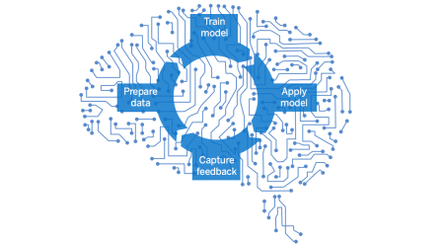In addition to the steps we've taken to strengthen the security of our CCCApply system, including additional firewall protections, blocking TOR and other known bad actors, and implementing pre-submission configuration changes that would prevent probable fraud applications from being submitted if they meet certain criteria, after the first wave of fraud was reported in late 2016, CCCApply contracted with a machine learning data research team to conduct an extensive research analysis on the fraud applications we collected from the colleges. Research ObjectivesInfiniti commenced a multi-phase research project with the following objectives:
|
One of the outcomes of the machine learning research study was to build a spam filter web service with user interface to prevent bad data from getting to the colleges and continuously re-training the prediction service model.
After the initial review, the data analysts recommended developing a spam filter service using on a continuous learning/training model - based on a custom algorithm that will get smarter each time an application is flagged as "spam". This filter service is being built for CCCApply Standard application, with a back-end user interface that will be accessible in the new CCCApply Administrator (deploying in June). Both the spam filter service and the admin interface are under-development now - with an expected release date of June 2018. This is a huge project and will require the cooperation and participation of all colleges - not just the colleges being targeted with spam - in order to "train" the algorithm with accurate data - both good, legitimate applications as well as the bad, fraudulent applications.
A comprehensive communication plan is mapped out, beginning with the announcement about the Spam Filter as part of the new CCCApply Administrator release- going out the week of March 19. Training webinars and user guides are being developed to accompany the new system.
Meanwhile, we continue to work with the machine learning team and several colleges in a pilot project to build and train the algorithm with any bad applications submitted by colleges. The email tomorrow will also specify how colleges can submit their fraud applications to the Tech Center for this purpose (we need them formatted in a specific way and ensure colleges know not to include any student personal identity information.
We are also working with the CCCApply Steering Committee to better understand the motivations of these spammers. What are they after?
Research Outcomes
Data Trends Identified in Fraud Applications
By recognizing the characteristics of spam applications, such as volume, average submission time, patterns in the submitted data, and user profiling - and comparing that information to non-fraud applications, we are able to take steps to prevent this threat through enhanced security, short-term stop gap fixes as needed, and the development of a spam filter web service. These aren't the only solutions, but as we continue to better understand the motivations behind these attacks, these can be used as part of an overall enhanced security strategy.
Early Research
In order to better understand trends and patterns within these fraud applications so thaThe Tech Center has contracted with a Machine Learning Research organization to better understand the make-up of fraud applications. In order to combat these frauds, we have to be able to identify them as they are coming in. To start we've pulled data for a two-part data analysis (without using any student personal information): the first data pull focused on one college that provided a large number of bad applications between June 1, 2016 - August 15, 2017; the second data pull looked at all other colleges who have provided examples of bad applications in the same time frame; and the third pull looked at all the remaining colleges and submitted application data. We need to compare the bad applications to good applications in order to start detecting trends and patterns in the fraudulent "formula".
After reviewing all three data pulls (again, no personal information was used in this analyses) we learned quite a bit already:
The majority of bad applications identified were submitted in under 3 minutes, with the majority of those being submitted in under 2.5 minutes. This information alone tells us that robots are submitting applications using keyboard strokes;
Of the applications identified as frauds, other patterns were prevalent:
- Time to completion: 2.25 minutes (average)
- Permanent Address State: NOT California
- Current Mailing Address State: NOT California
- Gender: Male
- Race: White
- HS Ed Level: No high school completion
- Interest in Financial Aid: NO
Research Outcomes: What We've Learned
Trends & Motivation for Fraudulent Activity
- seek special discounts on technology hardware and software
- selling the addresses on eBay and CraigsList (we've found them there)
- using the emails and other auto-responses that acknowledge their "California" address / residency to create fake identities
- apply for financial aid
Other Motivating Factors
- Some colleges are giving applicants free software licenses (Office 365). These licenses are being sold to end-users.
- In some instances, confirmation emails being sent to applicants are confirming their residency status (based on self-reported data). These are then being used to create fake identities.
- Student ids and other "identification codes" are allowing these fraud applicants to access the colleges' SIS (again, this is happening prior to registration).
